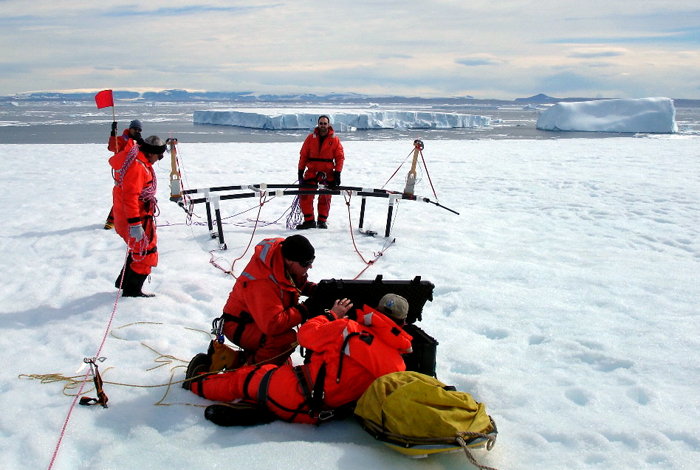Probing the iceLARISSA instruments to observe transformation to 'Alaskan style glaciation'Posted September 18, 2009
The LARISSA program Glaciologists on the multidisciplinary project studying the Larsen Embayment where two ice shelves have virtually disappeared in the last 15 years will have to wait a while before they start seeing results for what promises to be a busy field season. Ted Scambos The instruments, some of which include high-precision GPS and high-resolution cameras, should give the scientists additional insight into how the glaciers in the area behave as well as how the remaining piece of the Larsen B Ice Shelf evolves, according to Scambos. The researchers will outfit five sites — including a high, rocky outcrop overlooking the remnant ice shelf, what Scambos now refers to as the Scar Inlet Ice Shelf — with AMIGOs. The Automated Meteorology Ice Geophysics Observation systems have built-in GPS units and cameras as well as weather instruments. Scambos employed them for a separate project called IceTrek “They’re almost like space probes. The only thing they’re missing are the wheels or the little arms that dig a trench in the snow,” noted Scambos, who is in the process of upgrading the AMIGO software and components for the LARISSA program. The AMIGO stations will store high-resolution images of the ice shelf and nearby glaciers, sending smaller thumbnail pictures via Iridium satellite to the scientists back stateside based on pre-programmed instructions. Scambos said it will be possible to reprogram the probes remotely if the data they send back warrants a change in plans. “That’s the thing that kind of makes it like a space probe,” he said. “We can tell it to do things slightly differently based on what we think is going on from afar.” In addition to the AMIGO stations, which require at least a couple of days to set up at each site, Pettit will install seismic instruments on the coast to collect information about the interaction between the ice and bedrock by “listening” to sounds created as ice crashes into the sea. “In Greenland, apparently, there are these small ice quakes associated with large calving events in the spring and summer as these glaciers respond to the annual warming,” Scambos said. The hope is that the Scar Inlet Ice Shelf and its glaciers will continue to thin and retreat to allow the glaciologists to learn more about ice dynamics from the instruments, such as flow rate, crevassing and the melt pools that form on the surface, which weaken the ice. “All of these things will give us a real clear picture of an area that is in the process of transitioning from an Antarctic style of glaciation to an Alaskan style of glaciation,” Scambos said, referring to tidewater glaciers that flow directly into the sea rather than into an ice shelf. “This remnant shelf is really teetering on the edge. If we get another warm summer, we’re thinking we’ll see a little more retreat,” he added. “We’ll be able to watch that process in detail.” NSF-funded research in this story: Ted Scambos, University of Colorado at Boulder, Award No. 0732921 |



For USAP Participants |
For The Public |
For Researchers and EducatorsContact UsU.S. National Science FoundationOffice of Polar Programs Geosciences Directorate 2415 Eisenhower Avenue, Suite W7100 Alexandria, VA 22314 Sign up for the NSF Office of Polar Programs newsletter and events. Feedback Form |



